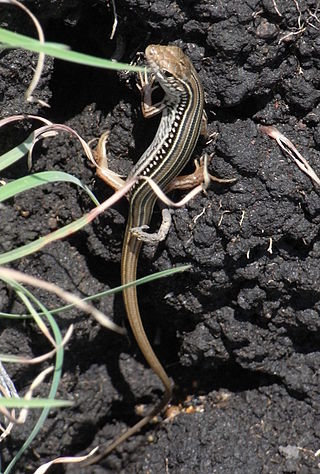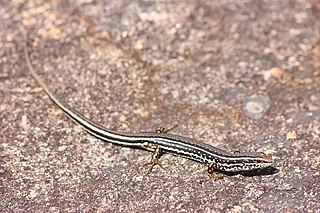
Ctenotus is a genus of skinks, lizards in the family Scincidae. The genus is endemic to Australia. The genus Ctenotus belongs to a clade in the Sphenomorphus group which contains such genera as Anomalopus and the close relatives Eulamprus and Gnypetoscincus.
The Lancelin Island skink, also known commonly as the Lancelin south-west ctenotus and the south-west ctenotus, is a species of skink, a lizard in the subfamily Sphenomorphinae of the family Scincidae. The species is endemic to Australia.
The Hamelin ctenotus or Hamelin Pool ctenotus is a species of skink in the family Scincidae. It is found only in Western Australia.

Alexander Strauch was a Russian naturalist, most notably a herpetologist.
Enneapterygius rhabdotus, the umpire triplefin or South Pacific striped triplefin, is a species of triplefin blenny in the genus Enneapterygius. It was described by Ronald Fricke in 1994. This species occurs in the western central Pacific Ocean the Izu Peninsula in Japan, Taiwan, Batanes and Palawan in the northern Philippines, the Gulf of Thailand, Palau, and most of Melanesia east to the Pitcairn Islands.

Ctenotus robustus, the eastern striped skink, is a species of skink found in a wide variety of habitats around Australia. They are long-tailed, fast moving skinks that are quite large, growing to a maximum length of about 30 cm. This skink is mostly brown with a white-edged black stripe running down the length of its back and tail with broad brown stripes along the side of the body with rows of white spots. The sides become lighter, turning into an off-white colour towards the underside of the skink, running from the groin to the chin. The striped skink is similar in appearance to the spotted-back skink with the main identifying difference being the solid stripe running down the back of C. robustus whereas C. uber orientalis has a row of dots.
Ctenotus zebrilla, also known commonly as the Southern Cape York fine-snout ctenotus, is a species of skink, a lizard in the family Scincidae. The species is endemic to Australia.

Ctenotus pantherinus, commonly known as the leopard ctenotus, is a species of skink endemic to central and western Australia. Its conservation status is currently classified as Least Concern.

Sphaerodactylus rhabdotus, also known as the two-striped sphaero or Valle de Neiba least gecko, is a small species of gecko endemic to the Dominican Republic.
Ctenotus angusticeps, the northwestern coastal ctenotus, little leopard ctenotus, or Airlie Island ctenuous, is a species of skink found in Western Australia.

Ctenotus burbidgei, also known commonly as the plain-backed Kimberley ctenotus, is a species of skink, a lizard in the family Scincidae. The species is native to Western Australia.
Ctenotus capricorni, the Capricorn ctenotus, is a species of skink found in Queensland in Australia.

Ctenotus inornatus, the bar-shouldered ctenotus, is a species of skink found in the Northern Territory, Queensland, Victoria, New South Wales, and Western Australia.
Ctenotus kurnbudj, the Kurnbudj ctenotus, is a species of skink found in the Northern Territory in Australia.

Ctenotus labillardieri, also known commonly as the common south-west ctenotus, Labillardier's ctenotus, and the red-legged ctenotus, is a species of skink, a lizard in the family Scincidae. The species is endemic to the Australian state of Western Australia.

Ctenotus leonhardii, known by the common names Leonhardi's ctenotus, Leonhardi's skink or common desert ctenotus, is a species of skink found in a range of arid and semi-arid regions throughout mainland Australia. The species was named after German anthropologist Moritz von Leonhardi in 1919 and belongs to the genus Ctenotus, one of the largest genera of lizards in Australia.
Ctenotus stuarti, also known commonly as the Point Stuart ctenotus or Stuart's ctenotus, is a species of skink, a lizard in the family Scincidae. The species is endemic to Australia.
The wide-striped ctenotus is a species of skink found in Western Australia.
Ctenotus youngsoni, also known commonly as the Shark Bay south-west ctenotus and Youngson's ctenotus, is a species of skink, a lizard in the family Scincidae. The species is endemic to Australia. The specific name, youngsoni, is in honour of Australian zoologist William Kenneth Youngson. C. youngsoni is found in the Australian state of Western Australia. The preferred natural habitat of C. youngsoni is shrubland. C. youngsoni has well-developed limbs, with five toes on each of its four feet. C. youngsoni is oviparous.







